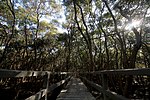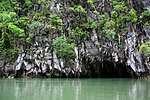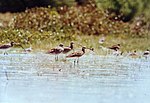List of Ramsar sites in the Philippines

The Ramsar Convention (formally, the Convention on Wetlands of International Importance, especially as Waterfowl Habitat) is an international treaty for the conservation and sustainable utilization of wetlands,[1] recognizing the fundamental ecological functions of wetlands and their economic, cultural, scientific, and recreational value. It is named after the city of Ramsar in Iran, where the Convention was signed in 1971.
The Philippines enforced the Ramsar Convention in its whole territory on November 8, 1994. Since then, Ramsar has designated 7 Ramsar sites in the country. Two Ramsar sites in the Philippines have been declared by UNESCO as world heritage sites, namely Puerto Princesa Subterranean River National Park, and Tubbataha Reefs Natural Park.[2]
A national inventory of wetland resources, based on the best scientific information available, is mandated by the Convention since 1990 through Recom 4.6. A Framework for Wetland Inventory was also established by the Convention in 2002 to aid member states in establishing their own national inventory for wetland sites. The inventory makes it possible to prioritize appropriate wetland sites for designation on the Ramsar List, similar to the tentative list of UNESCO, where UNESCO sites must always come from the tentative list. There is currently no publicly disclosed wetland inventory in the Philippines, but it is assumed that such inventory exists as the Philippines, through the Department of Environment and Natural Resources, has already nominated at least seven Philippine wetlands since 1994.
The current representation of the Philippines in Ramsar wetland nominations is inactive compared with the Ramsar wetland nominations of its peers. By comparison, the Philippines has 7 sites, while Mexico has more than 140, the archipelagic country of Japan has more than 50, the African nation of Algeria has more than 50, and the small country of South Korea has 22. The Philippines, an archipelagic country, theoretically possesses more wetlands than South Korea and North Korea combined. This has prompted various scholars to push the government to participate more in the nominations of Philippine wetlands in the Ramsar Convention. By rule, the Philippines may nominate multiple sites as Ramsar sites like what Mexico did in 2008, where at least 45 of its nominated sites were specifically declared as new Ramsar sites.[3]
Designated sites
See also
- Environment of the Philippines
- List of protected areas of the Philippines
- Biosphere reserves of the Philippines
- List of World Heritage Sites in the Philippines
- List of Ramsar sites
References
- ^ Ramsar official website, retrieved July 10, 2011
- ^ "Philippines | Ramsar". www.ramsar.org.
- ^ "Designating Ramsar Sites | Ramsar". www.ramsar.org.
- ^ a b c d e f g "Philippines". The Ramsar Convention. Retrieved April 26, 2016.






